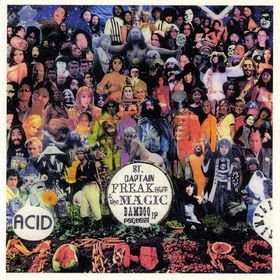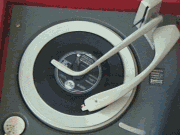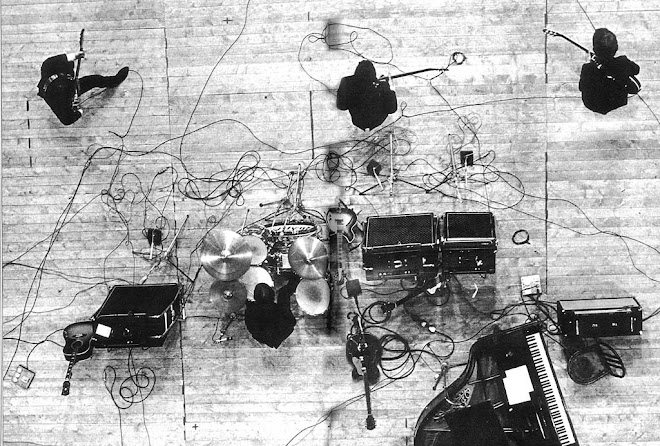
Catalogue No.'s: PMC 7009 (Mono) PCS 7009 (Stereo) CDP 7 46441 2
Matrix No.'s:
1st Press Mono : XEX 605-2 XEX 606-1
1st Press Stereo : YEX 605-1 YEX 606-1
Mono : XEX 605-2 XEX 606-2
Mono : XEX 605-2 XEX 606-3
Stereo: YEX 605-2 YEX 606-2
Total time 34:11
U.K. Album Chart Detail:
Highest Position : 1 ... for 7 weeks from 13th August 1966
Weeks in Chart : 34
+6 from 9th May 1987 (CD release, reached no.55)
+6 from 11th April 1998 (reached no.46)
Detail:
This release came out the same day as the double-A sided single, "Eleanor Rigby/Yellow Submarine" ... the first time that the Fab Four had released a single on the same day as the album from which the tracks came.
Arguably showing the Beatles at their creative zenith. Lyrically and musically innovative, "Revolver" IS a pop masterpiece.
It's original title was to be "Abracadabra", but this was rejected as it had been used by someone else (this didn't stop Steve Miller years later)
Revolver had advance orders of 300,000 in Britain and yet, is only given a final sale figure of 500,000. Globally, sales are estimated at over two million.
Front cover features artwork by Klaus Voormann, a friend of The Beatles from their Hamburg days. Voormann went on to play bass with Manfred Mann (he replaced Jack Bruce !) and later, of course, played with John and the Plastic Ono Band.
Look dead centre at the Revolver sleeve above, and then look at the original Robert Freeman picture below it from 1966 ! ... Klaus Voorman used this picture as the centrepiece (which may explain to you why John looked "odd").
The rear cover photograph is by Robert Whitaker.
The album was also part of "The Beatles Collection" 13 album box set (see Beatles Collection).
On 30th April 1987 this album had it's first release on C.D. which was published in stereo, with a catalogue number of CDP 7 46441 2
And on the same day, the record shop H.M.V. produced a special 12" numbered 3 CD Box Set Comprising:
Help
Rubber Soul
Revolver
+ "Beatles Monthly No.12" - July 1964
This set had a catalogue number of BEA CD 25/2, and was in a limited edition of just 2,500 copies.
The C.D. was also part of "The Beatles Box" 15 C.D. box set (see Beatles C.D. Box).
The album was also available on 4" reel-to-reel tape,
1966 - Catalogue number TA-PMC 7009 (3¾ ips twin-track mono tape) - first edition (mono only) in a cardboard box.
1968 - Catalogue number TA-PMC 7009 (3¾ ips twin-track mono tape)
TD-PCS 7009 (3¾ ips 4-track stereo) these editions in a "jewel" box.
Prior to 1973:
The album was released on stereo cassette tape (1⅞ ips) - Catalogue number - TC-PCS 7009.
The album was also released on 8-track stereo continuous play cartridge (3¾ ips) - catalogue no. 8X-PCS 7009
In November 1987 the album was re-released on cassette tape (stereo only) - Catalogue number - TC-PCS 7009 (Originally released September 1966).
Tracks:
Taxman Harrison Recorded 20th April 1966 - 4 takes ... all discarded.
Recorded 21st April 1966 11 new takes (Takes 1-11)
Recorded 22nd April 1966 overdubs, creating Take 12
Final mix - take 12. 2:35
Eleanor Rigby Lennon-McCartney Recorded 28th April 1966 in 15 takes
Vocals added to vacant track 29th April 1966 (still, Take 15) Final vocal overdub, 6th June 1966
Final mix - take 15. 2:04
I'm Only Sleeping Lennon-McCartney Recorded 27th April 1966 in 11 takes
Overdubs added to take 11 - 29th April
Overdubs added to take 11 - 5th May
Overdubs added to take 11 - 6th May making takes 12 & 13
Final mix - take 13. 2:58
Love You To Harrison Original working title, "Granny Smith"
Recorded 11th April 1966 in 6 takes
Recorded 13th April 1966 one more take, Take 7
Final mix - take 7. 2:58
Here, There And Everywhere Lennon-McCartney Recorded 14th June 1966 in 4 takes
Recorded 16th June 1966 - 10 takes (5-14)
Final mix - take 14. 2:22
Yellow Submarine Lennon-McCartney Recorded 26th May 1966 in 5 takes
Sound effects overdubs 1st June 1966 onto take 5
Final mix - take 5. 2:36
She Said She Said Lennon-McCartney Recorded 21st June 1966 in 4 takes
Final mix - take 4. 2:34
Side 2
Vocal overdubs onto take 1
Final mix - take 1. 2:07
And Your Bird Can Sing Lennon-McCartney Recorded 20th April 1966 - 2 takes
Remake recorded 26th April 1966 11 takes (Takes 3-13)
Final mix - take 10 and take 4. 1:58
For No One Lennon-McCartney Recorded 9th May 1966 in 10 takes
Overdubs added 16th May ending with takes 13 & 14
More overdubs 19th May onto take 14
Final mix - take 14. 1:58
Dr. Robert Lennon-McCartney Recorded 17th April 1966 in 7 takes, backing track only.
Vocal overdubs onto take 7 (on spare track)
Final mix - take 7. 2:13
I Want To Tell You Harrison Original title, "Laxton's Superb", then entitled, "I Don't Know"
Recorded 2nd June 1966 in 5 takes
Final mix - take 4. 2:26
Got To Get You Into My Life Lennon-McCartney Recorded 7th April 1966 - 5 takes
Recorded 8th April 1966 - 3 takes (Takes 6-8)
Overdubs and vocals added 18th May 1966 - 3 takes (9-11)
Final mix - take 9 with the brass from take 8. 2:26
Tomorrow Never Knows Lennon-McCartney Original working title, "Mark I"
What a start ... dare I say, the most innovative track on the album - years ahead of it's time, and yet, the very first track recorded at the start of the Revolver sessions.
Recorded 6th April 1966 in 3 takes
Take 1 is sensational ... seek it out. Take 2 was a breakdown
Final mix - take 3 with further overdubs made on 7th and 22nd April. 2:56
Mono/Stereo Differences
"Taxman" The mono version has a cowbell that starts during the second verse, on the stereo release it does not start until half-way through the second chorus.
"I'm Only Sleeping" The Lennon lead vocal is the same in both, but in the mono version the backwards guitar effects are in different places to the stereo mix.
"Yellow Submarine" The mono version has an opening guitar chord, which is missing on the stereo version.
The mono version has John's shouted repeats of Ringo's lines beginning one line sooner, and louder than on the stereo version.
"Got To Get You Into My Life" The mono version has a different sounding Paul during the fade-out than that on the stereo version.
"Tomorrow Never Knows" The mono version has different backwards tape effects than those on the stereo version.
Released Versions
The standard yellow block writing Parlophone label.
The "All rights of the manufacturer" message around the edge of the label now starts with "The Gramophone Co. Ltd."
The label DOES have "Sold in the U.K..." statement.
There is a much rarer mono version [very] first pressing, hastily withdrawn, which had a different mix of "Tomorrow Never Knows" (known as "remix 11") this has a matrix number on side 2 of XEX 606-1 and is worth up to £200 !
The standard yellow block writing Parlophone label.
The "All rights of the manufacturer" message around the edge of the label starts with "The Gramophone Co. Ltd."
The label does NOT have "Sold in the U.K..." statement.
Now with a silver/black Parlophone label.
The "All rights of the manufacturer" message around the edge of the label now starts with "EMI Records Ltd."
The label has one EMI boxed logo.
Silver/black Parlophone label.
The "All rights of the manufacturer" message around the edge of the label now starts with "EMI Records Ltd."
The label has TWO EMI boxed logos.
Now with a yellow/black Parlophone label.
The "All rights of the manufacturer" message around the edge of the label now starts with "EMI Records Ltd."
This release is on a lightweight vinyl.
Now with a Black and Silver Parlophone label.
The sleeve has a printed statement which reads:
"This album has been Direct Metal Mastered From a Digitally Re-mastered Original Tape to give the best possible sound quality"
This release is (surprisingly) on a lightweight vinyl.
Detail of the Russian sleeve, with DIFFERENT collage








 The News:
The News:















 Many "covers" were just a few seconds of fucking around: a single jokey chorus or intro lick. But the range was encyclopedic, from Cole Porter's "True Love" and Jimmy Webb's "MacArthur Park" to "To Kingdom Come," a Harrison favorite from the Band's 1968 debut, Music From Big Pink. The first thing McCartney played on the morning of January 3rd, while waiting for Harrison and Lennon to show up for work, was a solo piano stab at "Adagio for Strings," a 1938 piece by the American composer Samuel Barber.
Many "covers" were just a few seconds of fucking around: a single jokey chorus or intro lick. But the range was encyclopedic, from Cole Porter's "True Love" and Jimmy Webb's "MacArthur Park" to "To Kingdom Come," a Harrison favorite from the Band's 1968 debut, Music From Big Pink. The first thing McCartney played on the morning of January 3rd, while waiting for Harrison and Lennon to show up for work, was a solo piano stab at "Adagio for Strings," a 1938 piece by the American composer Samuel Barber.















































